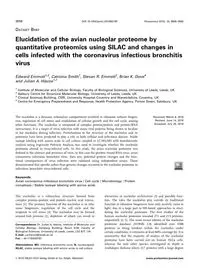
2010 Elucidation of the avian nucleolar proteome by quantitative proteomics using SILAC and changes in cells infected wi PDF
Preview 2010 Elucidation of the avian nucleolar proteome by quantitative proteomics using SILAC and changes in cells infected wi
DATASET BRIEF Elucidation of the avian nucleolar proteome by quantitative proteomics using SILAC and changes in cells infected with the coronavirus infectious bronchitis virus Edward Emmott1,2, Catriona Smith1, Stevan R. Emmett3, Brian K. Dove4 and Julian A. Hiscox1,2 1 Institute of Molecular and Cellular Biology, Faculty of Biological Sciences, University of Leeds, Leeds, UK 2 Astbury Centre for Structural Molecular Biology, University of Leeds, Leeds, UK 3 Clinical Sciences Building, CSRI, University Hospital Coventry and Warwickshire, Coventry, UK 4 Centre for Emergency Preparedness and Response, Health Protection Agency, Porton Down, Salisbury, UK Received: March 4, 2010 Revised: June 14, 2010 Accepted: July 25, 2010 The nucleolus is a dynamic subnuclear compartment involved in ribosome subunit biogen- esis, regulation of cell stress and modulation of cellular growth and the cell cycle, among other functions. The nucleolus is composed of complex protein/protein and protein/RNA interactions. It is a target of virus infection with many viral proteins being shown to localize to the nucleolus during infection. Perturbations to the structure of the nucleolus and its proteome have been predicted to play a role in both cellular and infectious disease. Stable isotope labeling with amino acids in cell culture coupled to LC-MS/MS with bioinformatic analysis using Ingenuity Pathway Analysis was used to investigate whether the nucleolar proteome altered in virus-infected cells. In this study, the avian nucleolar proteome was defined in the absence and presence of virus, in this case the positive strand RNA virus, avian coronavirus infectious bronchitis virus. Data sets, potential protein changes and the func- tional consequences of virus infection were validated using independent assays. These demonstrated that specific rather than generic changes occurred in the nucleolar proteome in infectious bronchitis virus-infected cells. Keywords: Avian coronavirus infectious bronchitis virus / Cell cycle / Microbiology / Protein complexes / Stable isotope labeling with amino acids The nucleolus is a subnuclear structure formed from complex protein–protein and protein–nucleic acid interac- tions [1]. The primary function of the nucleolus is in ribo- some biogenesis, regulation of the cell cycle and the response to cell stress [2]. The nucleolus may be formed around hub proteins [1], depletion of which can result in alterations in nucleolar architecture [3] and possibly func- tion. The roles the nucleolus play outside its traditional function in ribosome biogenesis have only recently come to light, due in a large part to MS-based approaches to eluci- dating the nucleolar proteome. The first studies of the human nucleolar proteome revealed 271 and 213 proteins, respectively [4, 5]. The most recent edition of the nucleolar proteome database (NOPdb 3.0) identified over 4500 proteins as being resident within the nucleolus under certain conditions; it estimates at least 80% coverage [6]. It is noteworthy that the majority of studies of the nucleolar proteome have been carried out on human HeLa cells, whereas the only other species investigated in depth is Arabidopsis thaliana where 217 proteins with a large degree Abbreviations: IBV, infectious bronchitis virus; N, nucleocapsid; SILAC, stable isotope labeling with amino acids in cell culture Correspondence: Dr. Julian A. Hiscox, Institute of Molecular and Cellular Biology, Garstang Building, Room 8.58, Faculty of Biological Sciences, University of Leeds, Leeds, LS2 9JT, UK E-mail:
